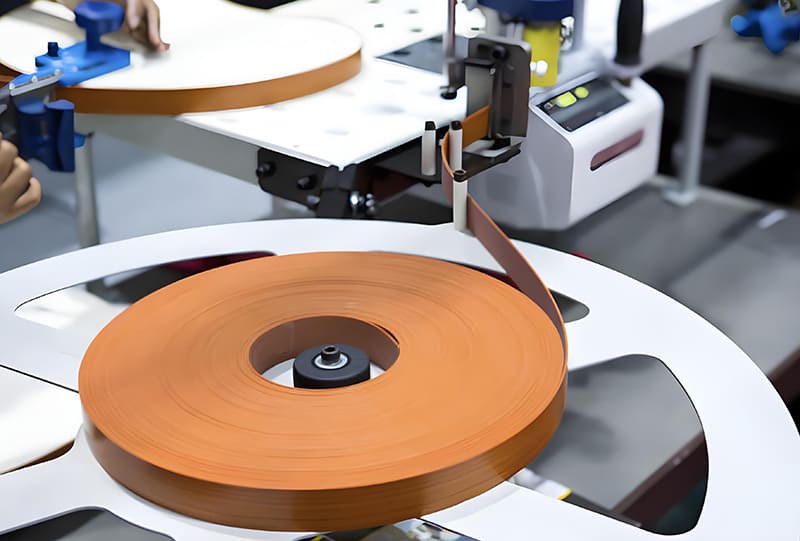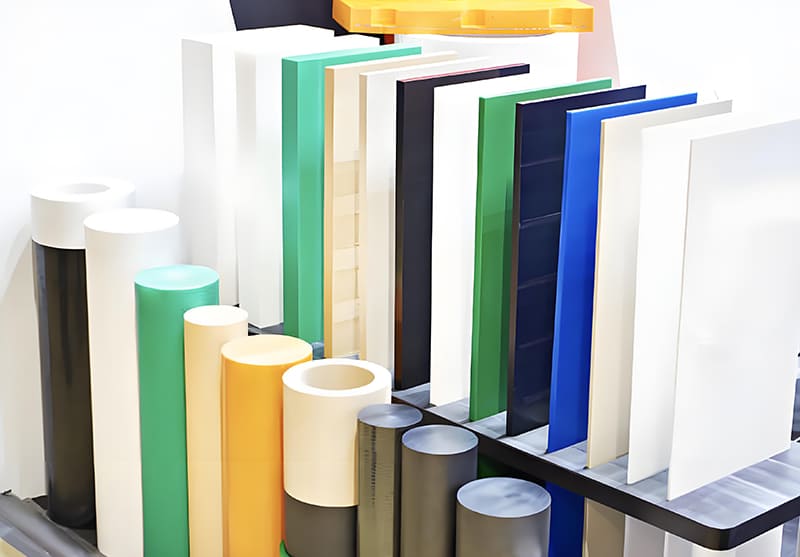
Edge banding is an essential component in woodworking, especially when it comes to creating clean, professional finishes for furniture, cabinets, and countertops. By applying a narrow strip of material to the edges of wood panels, edge banding provides both aesthetic appeal and added durability. In this article, we will explore the different types of edge banding materials, highlighting their uses, advantages, and ideal applications to help you make the best choice for your woodworking projects.
Edge banding is the process of covering the raw edges of wood panels with a thin strip of material. This helps protect the wood from damage, moisture, and wear, while also enhancing its appearance. It's particularly useful for plywood, MDF, and particle board, which often have unattractive or rough edges that need finishing.
Protection: Edge banding helps protect the edges of wood panels from chipping, cracking, and absorbing moisture.
Aesthetic Appeal: It provides a polished, finished look that elevates the overall appearance of the furniture or cabinetry.
Durability: With edge banding, you enhance the longevity of your wood products, as it makes them more resistant to daily wear and tear.
| Benefit | Description |
|---|---|
| Protection | Guards against moisture and physical damage |
| Aesthetic Appeal | Improves visual finish of furniture |
| Durability | Enhances longevity and robustness of wood products |
Using edge banding in furniture not only makes the item more durable but also transforms it into an attractive piece. Imagine a well-made table where all edges are smooth and protected—that’s the magic of edge banding.
PVC edge banding is one of the most popular types of materials used for covering the edges of wood panels. PVC (Polyvinyl Chloride) is a plastic material that is durable, flexible, and easy to work with, making it ideal for both residential and commercial applications.
Durability: PVC is known for its robustness. It resists moisture and chemicals, which makes it perfect for high-use furniture like cabinets and countertops.
Flexibility: This type of edge banding can easily be bent and shaped, which is ideal for rounded or curved edges.
Variety of Colors and Finishes: PVC edge banding comes in a variety of colors, finishes, and even textures, allowing you to match it perfectly to your furniture's design.
| Feature | Benefit |
|---|---|
| Durability | Resistant to wear, moisture, and chemical exposure |
| Flexibility | Easily conforms to different shapes and edge styles |
| Variety | Wide range of finishes for aesthetic customization |
PVC edge banding is highly flexible and available in numerous colors and finishes.
Ideal Applications: PVC edge banding is perfect for kitchen cabinets, office furniture, and other high-traffic areas where durability is a key factor. It can withstand frequent cleaning and daily use without deteriorating.
ABS (Acrylonitrile Butadiene Styrene) is another type of plastic material used for edge banding. It is similar to PVC but is considered an eco-friendlier option since it is free from chlorine and other harmful substances.
Eco-Friendly: Unlike PVC, ABS is non-toxic and more environmentally friendly, making it an excellent choice for sustainable projects.
Heat Resistance: ABS has a higher resistance to heat compared to PVC, which is advantageous in applications like kitchen cabinetry near stoves or ovens.
Lightweight: ABS edge banding is lighter, which makes it easier to handle and apply during installation.
ABS edge banding is commonly used in residential furniture where environmental considerations are a priority. It is a preferred choice for projects that focus on reducing their carbon footprint.
Veneer edge banding consists of a thin strip of real wood, typically around 0.5 mm to 3 mm thick. It’s ideal for anyone looking to create a natural wood finish for their projects, adding warmth and authenticity.
Pre-glued Veneer: This type of veneer edge banding has a layer of adhesive applied to one side, which simplifies the application process. All you need is a hot iron to melt the glue and affix it to the edge.
Non-glued Veneer: This type requires the application of glue separately but allows for more flexibility in choosing the adhesive type, depending on the specific requirements of the project.
Advantages: Veneer edge banding offers a more authentic look because it is real wood. It’s perfect for enhancing the natural beauty of wood furniture, especially when using solid woods like oak, walnut, or cherry.
| Type | Description |
|---|---|
| Pre-glued Veneer | Comes with adhesive, easy to apply |
| Non-glued Veneer | Adhesive added separately, customizable |
Veneer edge banding is often used in high-end furniture, where aesthetics play a significant role. It's commonly applied in cabinetry, custom shelving, and fine furniture.
Melamine edge banding is made from melamine-impregnated paper and is typically used to match laminate surfaces. Melamine is popular because it’s easy to apply, affordable, and comes in a wide range of colors and textures.
Affordable: Melamine edge banding is a cost-effective solution for covering panel edges.
Good Adhesion: Melamine bonds well to substrates, which helps provide a durable edge for furniture.
Matching Laminate: Melamine is usually matched to the laminate surfaces used on furniture or cabinets, providing a seamless appearance.
Use Cases: This type of edge banding is best suited for budget-friendly projects where aesthetics are important, but cost control is critical. It’s frequently used in shelving, office desks, and storage furniture.
Solid wood edge banding is made from strips of solid wood, offering the most natural and robust finish for wood panels. It provides a premium look and the durability that comes with using genuine wood.
Pros: Offers the most authentic look, matches perfectly with wooden panels, and can be sanded, stained, or finished to match other woodwork.
Cons: It is more expensive than other edge banding materials and requires more skill to apply correctly.
Solid wood edge banding is ideal for high-end furniture, custom cabinetry, and any application where durability and aesthetics are the main concerns.

Selecting the right adhesive is crucial for a successful edge banding project. The most common types of adhesives used are hot melt glue and contact cement.
Hot Melt Glue: Commonly used with PVC and melamine edge banding. It is applied with a hot glue gun or an edge banding machine and is ideal for mass production.
Contact Cement: Used for veneer and solid wood edge banding. It requires a more careful application but provides a very strong bond.
Each adhesive type has its advantages depending on the material and application. Make sure to choose an adhesive that’s compatible with both the edge banding and the substrate.
The method of applying edge banding depends largely on the type of material and the tools available.
Iron-On Method: This is mainly used for pre-glued veneer edge banding. Simply heat the glue with a household iron, press the edge banding in place, and trim the excess.
Hot Air Edge Banding Machine: Often used for PVC and ABS edge banding in commercial settings. This technique involves using a specialized machine to apply hot air and activate adhesive.
Manual Application with Contact Cement: For solid wood and non-glued veneer, contact cement is applied to both the edge band and the substrate, then pressed together once tacky.
To apply edge banding, you need a few essential tools to ensure that the process goes smoothly and yields a professional finish.
Edge Trimmer: For trimming excess edge banding to achieve a neat finish.
Block Plane: To smooth out any rough areas after applying solid wood edge banding.
Sandpaper: Used to ensure a smooth finish, especially when working with veneer or solid wood.
For precision, consider adding a high-quality edge trimmer and edge sanding block to your toolkit. These tools help achieve that perfect seamless finish that makes the furniture look polished and professional.
Each edge banding material comes with its own set of advantages and challenges. Here’s a comparative look at the main types:
| Material Type | Pros | Cons |
|---|---|---|
| PVC | Durable, flexible, affordable | Not eco-friendly |
| ABS | Eco-friendly, heat resistant | More expensive than PVC |
| Veneer | Authentic wood look | Requires more effort to apply |
| Melamine | Affordable, easy to apply | Less durable |
| Solid Wood | Premium look, robust | Expensive, challenging to apply |
Edge banding plays a crucial role in woodworking by providing both functional and aesthetic benefits to furniture and cabinetry. Whether you're working on kitchen cabinets, shelving, or custom wood furniture, selecting the right type of edge banding material can significantly impact the outcome of your project. From the durability of PVC and ABS to the natural beauty of veneer and solid wood, each material has its strengths. By understanding these options and how they fit your specific needs, you can ensure that your woodworking projects not only look great but also stand the test of time.
If you're looking for top-quality edge banding materials and tools to get started, explore our range of Edge Banding Tools and Woodworking Accessories. We’re here to support your next project every step of the way.
Contact: RicoCNC
Phone: 0086-13390848665
E-mail: cncsale@ricocnc.com
Whatsapp:0086-15264185266
Add: NO. 60, Weixin Road, Industrial Park, Suzhou, Jiangsu, China, 215000
We chat
